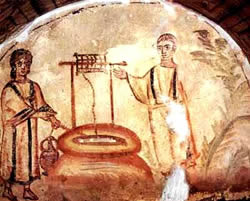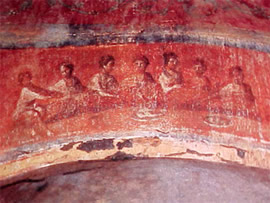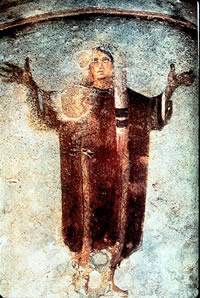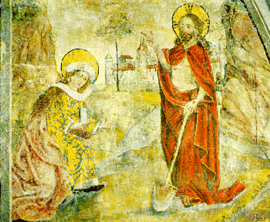Our "Illustrious God-Inspired Mothers:"
"They Were Remarkable Women Indeed"
For Sunday June 13, 2010
Lectionary Readings (Revised Common Lectionary, Year C)
1 Kings 21:1–10, (11–14), 15–21a or 2 Samuel 11:26–12:10, 13–15
Psalm 5:1–8 or Psalm 32
Galatians 2:15–21
Luke 7:36–8:3
This spring I enjoyed a brief binge reading the desert monastics of fourth century Egypt. Like most early Christian literature, and as you would expect from the harsh geography of the remote desert, most of what we know about these early ascetics is written by and about men. The Sayings of the Desert Fathers, collected and compiled from the fourth through the sixth centuries, for example, contains 1202 stories and aphorisms of 127 abbas and only three ammas or mothers—46 "sayings" of Theodora, Sarah, and Syncletica.
 |
Woman at the well, John 4. |
The Lives of the Desert Fathers is similar. It's written by seven monks from Jerusalem who journeyed to Egypt at the end of the fourth century to document the lives and teachings of the desert dwellers. A few passing references tantalize us with the offhand observation about "the throngs of monks and nuns past counting. As far as we could ascertain from the holy bishop of that place, we would say that he had under his jurisdiction ten thousand monks and twenty thousand nuns." Even if we allow for enthusiastic exaggeration, it's clear that many women flocked to the desert just like the men. But in most texts they remain nameless.
The Lausiac History by Palladius (c. 365–431), however, contains a shocking surprise. Similar in style and content to the two previous works, it contains seventy-one biographical "chapters" on ascetics in Egypt, Palestine, Syria and even Asia Minor. But in his very first paragraph Palladius says that he especially intends to honor the desert mothers: "It is written also to commemorate women far advanced in years and illustrious God-inspired mothers who have performed feats of virtuous asceticism in strong and perfect intention." These "holy highborn women," writes Palladius, "lived the best and loftiest lives."
Palladius names dozens of women they learned about, and documents the organized communities of thousands more. There's the "graceful maiden," slave, and martyr Potamiaena. He honors a servant named Alexandra. He recalls an order of women that numbered 300 renunciants "from every walk of life." Piamoun was "deemed worthy of the gift of prophecy." We meet Olympias, who "disposed of all her goods and instructed many women." We learn of Candida and "the most renowned Gelasia." "In the town of Antinoe," writes Palladius, "are twelve monasteries of women." And in the town of Ancyra "lived many other virgins, probably two thousand or more. They were remarkable women indeed."
 |
Women celebrating the eucharist. |
Chapter 41 is called "Saintly Women," and was written "to commemorate the courageous women to whom God granted struggles equal to those of men." It names a dozen women by name, one of whom led "a company of fifty virgins," including "the Roman matron Paula, a woman highly distinguished in the spiritual life. . . a genius of a woman."
Most prominent of all is "the blessed Melania," a Spanish woman who was widowed at the age of twenty-two. One of the wealthiest women of her time, after her husband died she traveled to Egypt where she "spent up to a half a year making the rounds of the desert and seeking out all the holy men." She built a monastery in Jerusalem from her private funds, lived there for twenty-seven years, headed a company of "fifty virgins," and supported from her private means the "bishops, solitaries, and virgins who visited them."
Palladius describes Melania as "most erudite and fond of literature, and she turned night into day going through every writing of the ancient commentators — three million lines of Origen and two and a half million lines of Gregory, Stephen, Pierius, Basil, and other worthy men. And she did not read them only once and in an offhand way, but she worked on them, dredging through each work seven or eight times." Melania is most famous for the instruction she gave to the renowned ascetic and fellow intellectual Evagrius of Pontus.
Luke's gospel for this week reminds us that perhaps we should not be surprised by these stories: "Jesus traveled about from one town and village to another, proclaiming the good news of the kingdom of God. The Twelve were with him, and also some women who had been cured of evil spirits and diseases: Mary (called Magdalene) from whom seven demons had come out; Joanna the wife of Cuza, the manager of Herod's household; Susanna; and many other women. These women were helping to support them out of their own means" (Luke 8:1–3).
 |
Woman at prayer. |
The prominence of women in the life of Jesus is deeply embedded in the gospels and highly unusual for that time and place. One time the disciples expressed amazement that Jesus even spoke to a woman (John 4:27). Respected rabbis would not have associated with women like Jesus did. A well-known prayer found in three rabbinic traditions (Tosephta, Palestinian/Jerusalem Talmud, and the Babylonian Talmud) thanks God for not being born a Gentile, a woman, or an ignorant man — none of whom enjoyed the privilege of studying the Torah.
Four infamous women are listed in Jesus's genealogy of forty-six names (Matthew 1:1–17). Tamar was widowed twice, then became pregnant by her father-in-law Judah who mistook her for a temple prostitute. The offspring of this incest were the twin boys Perez and Zerah. Perez is a relative of Jesus (see Ruth 4:18–21). Rahab was a foreigner and a whore who by her lies protected the Hebrew spies. She's mentioned three times in the New Testament: as a hero of faith (Hebrews 11:31), as an exemplar of good works (James 2:25), and as the great-great-grandmother of King David (Matthew 1:5). Ruth was a foreigner and widow who married the wealthy Boaz, King David’s great-grandfather. Bathsheba, the subject of David's adulterous passion and murderous cover-up, was the mother of King Solomon. These women were part of Jesus's family of origin.
Today the women mentioned by Luke are barely known to us. Mary Magdalene is mentioned several times in the Gospels, Joanna was a witness to the resurrection (Luke 24:10), while the identities of her husband Cuza, Susanna, and the "many other women" who supported Jesus remain lost to history. In Luke's day they must have been well-known people of financial means who had left their husbands and families in order to underwrite a sizeable group of itinerating evangelists. Perhaps they were some of those first believers who sold their lands and houses and used the money to support the Jesus movement (Acts 4:34). Whatever the particulars, when it came to following Jesus, they were, as the poker expression puts it, "all in."
 |
Jesus and Mary. |
These women traveled with Jesus and his followers for three years, supported them, witnessed his crucifixion, and then were the first heralds of the resurrection. Mark writes that at his death "some women were watching from a distance. Among them were Mary Magdalene, Mary the mother of James the younger and of Joses, and Salome. In Galilee these women had followed him and cared for his needs. Many other women who had come up with him to Jerusalem were also there" (Mark 15:41). After the ascension "the women" — as if their identities would have been obvious to the original readers — are also mentioned as part of the core disciples in the "upper room" (Acts 1:14).
It's no exaggeration to say that women from all walks of life deeply shaped and supported Jesus and his followers. Women, observed Dorothy Sayers, were "the first at the Cradle and the last at the Cross." In the words of Palladius's eyewitness accounts, they were our "God-inspired mothers" who were "remarkable women indeed."
For further reflection:
* In addition to the three works on the desert monastics mentioned above (which are short, inexpensive, and very readable), see Dorothy Sayers, Are Women Human? (Grand Rapids: Eerdmans, 1971, 2005), two essays from her collection of essays called Unpopular Opinions (1947).
Image credits: (1) J. Richard Stracke, Augusta State University; (2) Women-ChurchConvergence.org; (3) Millinerd.com; and (4) WomenPriests.org..





